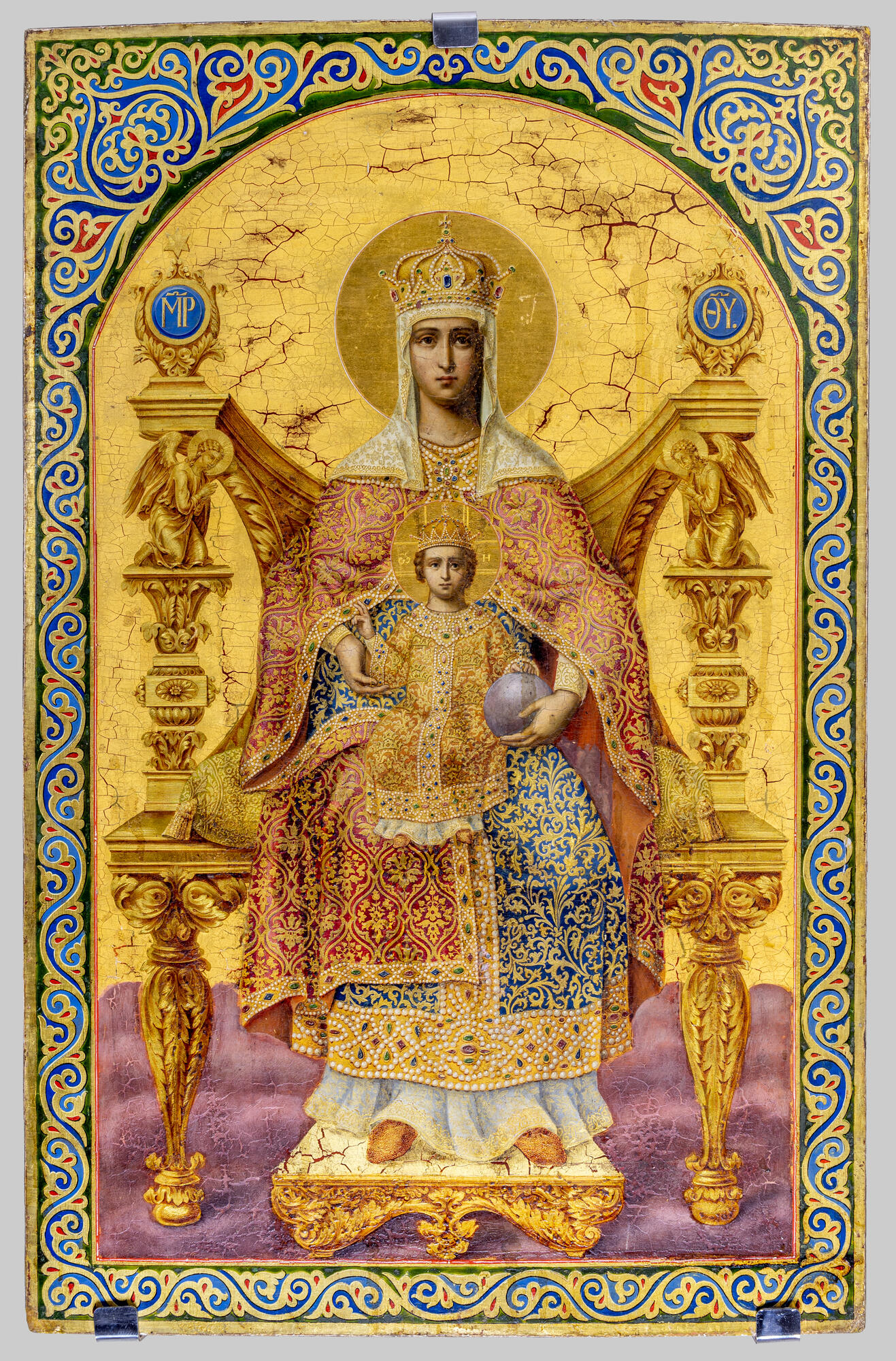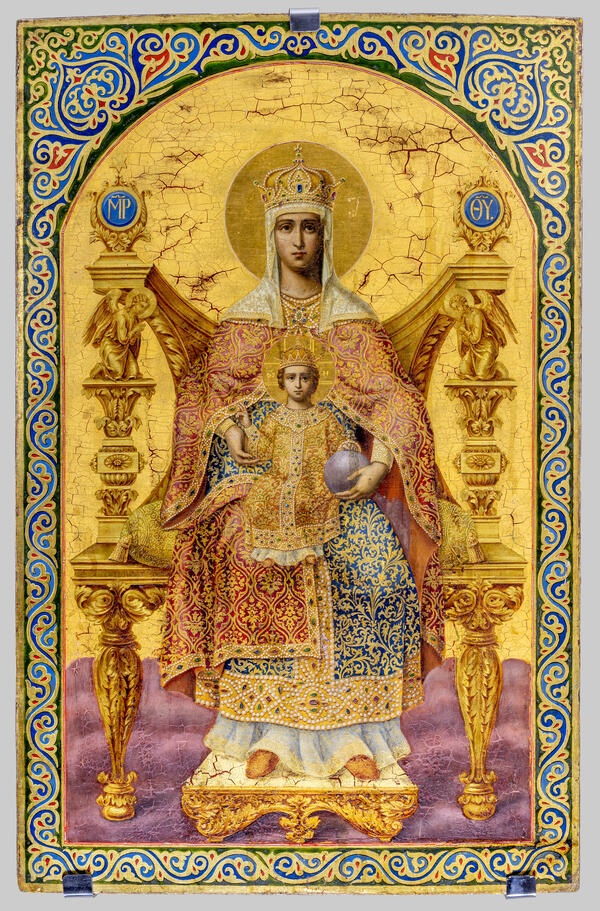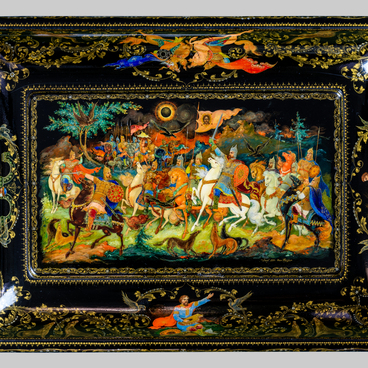Palekh masters Pyotr Nagovitsyn and Ilya Volkov painted the icons ‘The Savior on the Throne’ and ‘The Mother of God Enthroned’ in 1854. These artworks were created for the iconostasis of the Palekh Exaltation of the Cross Church. The artists worked in the Peshekhonov workshop — a famous iconography center in St. Petersburg founded by Makariy Peshekhonov. From the artworks of the Peshekhonov dynasty, the ‘peshekhonovsky’ style was born. It was particularly popular with people who commissioned icons in the second half of the 19th century.
This style is easily recognizable: this was the only style of icon painting that created the visages of the saints adhering to the traditions of the academic art. The volumes are modeled with light and shade, which gives the faces a natural look. The ‘peshekhonovsky’ icons were also generously adorned with golden ornaments. It is believed that it was these new aesthetic ideals that influenced the decoration of the Cathedrals of Christ the Savior in Moscow and St. Isaac’s Cathedral in St. Petersburg.
A distinctive feature of the “peshekhonovsky” style was the “tsirovka” technique — a special way of decoration, where a master scrapes a thick layer of paint with a thin needle all the way through to the golden background, just like metal engravings. With this technique the artists depicted ornate clothes of saints, imitating precious fabrics with pearls and stones sewn on.
Pyotr Nagovitsyn and Ilya Volkov created wonderful examples of the “peshekhonovsky” style. The stern faces of Christ and the Mother of God, their frozen postures, the abundance of gold and the attributes of royal power — all this gave the images an air of solemnity and monumentality.
Artists treated the gold differently on each icon. They used the precious metal polished to shine to create the thrones, angels (on the Mother of God icon), and symbolic animals (on the Savior icon). Nimbuses and cartouches with monograms are similarly fashioned (a cartouche is an emblem framed with curls). At the same time, the general golden background of e each icon is a matte surface.
There is so much gold on the icons that the color palette is hard to discern. It is subdued and subsumed by the shine and glitter of the precious metal. Although some complex hues are clearly present in the color table.
Adhering to the same academic tradition the artists used to create faces, they used asphalt for general shading and clothes shading (asphalt of the highest quality is used in painting and lithography). For that reason, the craquelure, especially on the visages, is similar to the craquelure seen on paintings of Russian artists of the second half of the 19th century. However, the cracks of a reddish hue on a gold background — which highlight the noble antiquity of the icon — are just a magnificent imitation of craquelure.
Both icons are signed by artists. The signatures are written in a very fine font and could be easily overlooked among the lush curls of ornamentation at the foot of each throne.
This style is easily recognizable: this was the only style of icon painting that created the visages of the saints adhering to the traditions of the academic art. The volumes are modeled with light and shade, which gives the faces a natural look. The ‘peshekhonovsky’ icons were also generously adorned with golden ornaments. It is believed that it was these new aesthetic ideals that influenced the decoration of the Cathedrals of Christ the Savior in Moscow and St. Isaac’s Cathedral in St. Petersburg.
A distinctive feature of the “peshekhonovsky” style was the “tsirovka” technique — a special way of decoration, where a master scrapes a thick layer of paint with a thin needle all the way through to the golden background, just like metal engravings. With this technique the artists depicted ornate clothes of saints, imitating precious fabrics with pearls and stones sewn on.
Pyotr Nagovitsyn and Ilya Volkov created wonderful examples of the “peshekhonovsky” style. The stern faces of Christ and the Mother of God, their frozen postures, the abundance of gold and the attributes of royal power — all this gave the images an air of solemnity and monumentality.
Artists treated the gold differently on each icon. They used the precious metal polished to shine to create the thrones, angels (on the Mother of God icon), and symbolic animals (on the Savior icon). Nimbuses and cartouches with monograms are similarly fashioned (a cartouche is an emblem framed with curls). At the same time, the general golden background of e each icon is a matte surface.
There is so much gold on the icons that the color palette is hard to discern. It is subdued and subsumed by the shine and glitter of the precious metal. Although some complex hues are clearly present in the color table.
Adhering to the same academic tradition the artists used to create faces, they used asphalt for general shading and clothes shading (asphalt of the highest quality is used in painting and lithography). For that reason, the craquelure, especially on the visages, is similar to the craquelure seen on paintings of Russian artists of the second half of the 19th century. However, the cracks of a reddish hue on a gold background — which highlight the noble antiquity of the icon — are just a magnificent imitation of craquelure.
Both icons are signed by artists. The signatures are written in a very fine font and could be easily overlooked among the lush curls of ornamentation at the foot of each throne.



